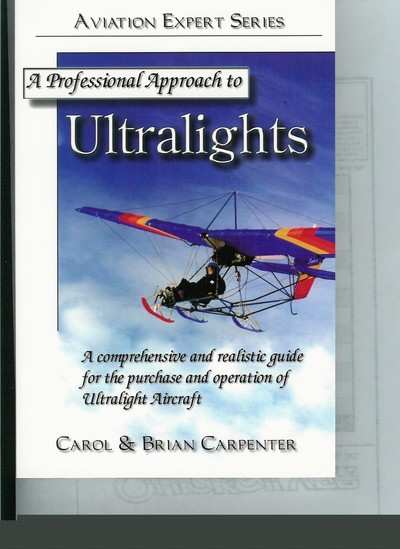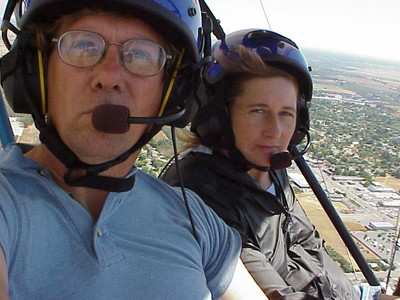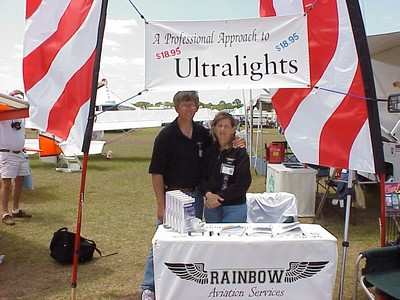By ANN Contributor Jon Thornburgh
According to FAA statistics only six percent of the licensed
pilots in the United States are women. In the ultralight
community less than one percent of the pilots are women. So
it's very unusual to come across a woman who not only is an
ultralight pilot but also an ultra-light instructor. Not only does
Carol Carpenter fly ultralights, she has also co-authored an
ultralight book with her husband, Brian.

It is quite unique for a husband and wife to write a book
together. Former President Jimmy Carter and his wife, Rosalynn,
wrote Everything to Gain: Making the Most of the Rest of Your
Life. During an interview promoting the book, Jimmy Carter
revealed that writing the book with his wife was the most difficult
task that he ever faced. He said that if it were not for their
strong Baptist faith and commitment to each other that the stress
of writing the book together could have lead to their divorce.
With the Carters' experience in mind, I was anxious to find out
what triumphs and tribulations the Carpenters experienced while
writing their book together. The book is called "A Professional
Approach to Ultralights." It was published in August 2003, and is
presently only available through the Carpenter's web site, although
Carol said that they are negotiating with Amazon.com to market the
book.
I met Carol and Brian at the 2004 Sun 'n Fun airshow in Lakeland
(FL). They shared space in the ultralight area of Sun 'n Fun with
the Quicksilver aircraft manufacturer. The Carpenter's beautifully
designed book cover features a single seat Quicksilver Sport on
snow skies. Thanks to Carol and Brian's easygoing personalities and
their colorful book cover their display table attracted many
interested enthusiasts every day.
The 254-page book contains ten Chapters and a thorough Appendix.
The material in the book is comprehensive, well illustrated, and
easy to read. The chapters cover subjects such as "Choosing an
Ultralight," "Training and Instruction," "Maintenance,"
"Meteorology," "Ultralight Aerodynamics," and "Frequently Asked
Questions." The material is valuable for both newcomers to
ultralight flying and veterans. The book is certain to become a
must-have addition to every ultralight pilot's library.
The Carpenters are uniquely qualified to write A Professional
Approach to Ultralights. Brian is an ultralight instructor and
examiner, an EAA Technical Counselor and Flight Advisor, an FAA
Certified Flight Instructor, and an A&P aircraft mechanic with
an Inspection Authorization rating (IA.) He has constructed several
ultralight and experimental aircraft and is the designer and
builder of the "Ranger" airplane, featured in several aviation
publications. Carol is an ultralight instructor, an FAA private
pilot, an FAA certified ground instructor, and she holds a
California Teaching Credential.
Although Carol was formerly a junior high school math and
English teacher, she and Brian now operate a full time flight
school in Corning, California. The school features instruction in
both ultralights and general aviation trainers. As a mechanic,
Brian does all the maintenance on the aircraft. Their web site
delineates the many services available at their flight school,
including training, builder's assistance, aircraft sales,
maintenance, and books for sale.
Corning is 120 miles north of Sacramento. Their facility has a
2700-foot runway, classrooms and an office, a large hangar, an EAA
club, and 15 small hangars for private airplanes. It also has
showers and other facilities for campers and RVs. Their goal is to
eventually have live-in units for visiting students who are on
vacation or retired.

So what's it like to co-author an aviation book with your
husband? "It's both a challenge and very rewarding," Carol
said as she kindly took time off from manning her booth to give me
an exclusive interview.
Carol got the idea for writing a book about ultralights from
hearing Brian answer the same questions over and over again to
newcomers to aviation. Carol said that neither she nor Brian could
have written the book alone. Brian has the expertise in aviation
and Carol has organizational and writing skills from her junior
high school teaching experience.
The first step in writing the book was to do research. They
studied other manuals, handouts, Internet articles, manufacturer's
literature, FAA advisories, and anything else that was
pertinent. They compiled and organized the information on
index cards. In addition to the research of written material, Brian
also talked to Carol in narrative form, as she typed on a laptop
computer. Brian would sometimes skip from one idea to the other, so
Carol would have to synthesize the material into a coherent whole.
Due to their busy schedule they would usually have to work on the
document at night, often from 10:00 pm to 2:00 am in the
morning.
As each Chapter developed, Carol and Brian would exchange floppy
discs. Brian would proofread the material and make his corrections
in blue. Carol would counter with corrections or changes in red.
Eventually they came to an agreement on how the material should be
presented for each subject. The book took two years of effort.
The writing style reflects Carol's input and the technical
material reflects Brian's input. Due to Brian's extensive knowledge
and attention to detail the information he gave Carol was often
very technical. Carol wanted to make the book more readable for new
aviation enthusiasts, so she often had to persuade Brian to
rephrase his thoughts in terms more understandable to the layman.
As a result of their synergy, the book reflects a balance between
Brian's technical explanations and Carol's down-to-earth writing
style.
In addition to drafting the manuscript they also prepared it for
publication. They added photographs and drawings to the text,
selected the font for the captions and chapter headings, and even
designed the cover. They used Adobe Pagemaker 7.0 to format the
chapter headings and Corel Drawing, Photo Shop, and Adobe
Illustrator for drawing the pictures. They even did their own
copyright research and obtained the ISBN bar code, used by scanning
machines at checkout counters.
The only aspect of their self-publishing endeavor that they did
not do themselves was actually print the books. However, they did
interview several potential printers, and learned to their surprise
that various printer's bids varied by as much as 400 per cent.
After selecting a printer they sent him a computer CD that allowed
him to electronically print every page from cover to cover.

After a short well-deserved rest, the Carpenters plan to
continue writing. They would like to write about ultralight
maintenance, and a training manual. After the FAA promulgates the
long-awaited Sport Pilot regulations, Carol and Brian plan to write
a book on the training procedures and opportunities available under
the Sport Pilot initiative.
In the meantime, Brian is constructing a 2000 square-foot house
for their personal residence. Brian is designing the house and
hammering each nail himself. The floor plan includes three
bedrooms, two baths, and a unique octagon-shaped dining room.
Although it would seem impossible that the Carpenters would have
time for any recreation, they have two horses for riding, and they
enjoy gardening. They also have an RV and touring kayaks.
How did Brian and Carol meet each other? Through aviation, of
course. Brian was Carol's instructor while she was taking flying
lessons in a Cessna 172 for her private pilot certificate. After
she obtained her pilot license she started flying ultralights, and
fell in love with the smaller flying machines.
The very next day after she passed her private pilot practical
test Carol entered the "Palms to Pines" air race sponsored by the
woman's aviation organization called the "Ninety-Nines."
Although she was a brand new pilot, Brian's instruction was so
thorough that she was able to compete in the cross-country race
from Santa Monica, California, to Bend, Oregon. Her co-pilot was
another woman who assisted with the navigation and weather
analysis.
Carol stressed that Brian was thoroughly professional while she
was a student and they didn't start "dating" until three months
after she received her pilot's license in October 2001. They got
married five months later in March 2002. Being so wrapped up in
aviation, I presumed that they were married in a balloon or
while skydiving. But Carol said with a wry smile, "No, we had a
very traditional wedding and a honeymoon in Cancun."
 ANN's Daily Aero-Term (05.05.25): Circle To Runway (Runway Number)
ANN's Daily Aero-Term (05.05.25): Circle To Runway (Runway Number) ANN's Daily Aero-Linx (05.05.25)
ANN's Daily Aero-Linx (05.05.25) NTSB Prelim: De Havilland DHC-1
NTSB Prelim: De Havilland DHC-1 Classic Aero-TV: The Boeing Dreamliner -- Historic First Flight Coverage
Classic Aero-TV: The Boeing Dreamliner -- Historic First Flight Coverage Airborne-NextGen 05.06.25: AF Uncrewed Fighters, Drones v Planes, Joby Crew Test
Airborne-NextGen 05.06.25: AF Uncrewed Fighters, Drones v Planes, Joby Crew Test





